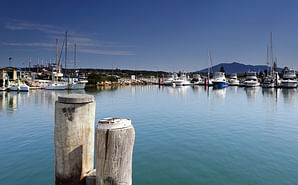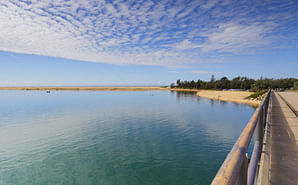Planting on Nature strips
A guide for planting on your nature strip.
This guideline is part of Policy 3.13 and Procedure 3.13.01. To view the policy and procedure visit Public Policies and search for the term 'trees and vegetation’.
This Guideline provides for a limited range of low-impact planting and landscaping activities that may be carried out on nature strips by residents in urban areas with a road speed limit of 60km/hr or less, without requiring further approval from Council under the Roads Act 1993. The Guideline complements Council’s Procedure 5.02.07 Private works on verges and road reserves, which shall be referenced for all proposed activities on nature strips that require approval.
On this page
- Things to know before getting started
- Getting started - Step 1: Information gathering
- Getting started - Step 2: Design principles and requirements
- Getting started - Step 3: Work safely
- Plants endorsed for Bega Valley nature strips
- Plants to avoidfor Bega Valley nautre strips
Things to know before getting started
Nature strips are public land
The nature strip is the part of the road reserve between the private property front boundary and the road, and therefore is public land.
Residents are encouraged to take pride in maintaining the nature strip. Residents who wish to beautify the nature strip with landscaping directly in front of their property boundary may do so, but only in a way that provides for safe access and use by the public.
If nature strip activities on a street verge are creating risks for pedestrians or traffic, or environmental impacts, Council may take action to remove the planting or landscaping and rectify the problem or issue an order to do so.
Nature strips contain important infrastructure
Most nature strips contain important public utilities, such as fire hydrants, electricity pillars, water and sewerage pipes, powerlines, telecommunication lines, footpaths, stormwater pipes and/or table drains. If you damage any of this infrastructure, you are liable for the cost of repair.
Be aware that if access for works to infrastructure (above or below ground) is required, including construction of footpaths or shared paths, the nature strip landscaping could be excavated, damaged or removed. Residents landscaping nature strips do so at their own risk. Council will not remediate any landscaping work undertaken by residents that is damaged by Council or another infrastructure authority carrying out infrastructure works in the nature strip. Wherever possible, when Council is planning works that may impact on a nature strip garden, residents will receive advanced notice of the works. Note that other utility providers (telecommunications, electricity, etc.) may not give advanced notice of works.
Your property may be bushfire prone land
Where land is mapped as being bushfire prone, the nature strip may contribute to an area of “managed land”, and the presence of limited flammable vegetation may be relied upon to protect from potential bushfire.
Be prepared to maintain it
Establishing a garden will require ongoing maintenance and weeding. Plants must be pruned so that they don’t grow over pathways, neighbour’s driveways, or the kerb.
Getting started
Before getting started, you will need to do some research and planning. The following following stesps will walk you through what you need to consider before you plant on nature strip.
Step 1: Information gathering
Before starting, check the following:
- Do you live in a bushfire prone area?
- Check the mapping by looking up your property address at: www.planningportal.nsw.gov.au/spatialviewer
- In the left hand side “Layers” table, scroll down until you see the heading: Hazard.
- Turn on the layer: Bushfire Prone Land (Non EPI)
- Zoom out until you can see the yellow, orange and red bushfire prone land mapping. If the nature strip is within the yellow, orange or red mapping, then the land is bushfire prone. If you are unsure, turn the Bushfire Prone Land layer on and off to see if it applies to the land.
- Be aware that even if your land is not mapped as being bushfire prone, it may still be subject to an ember attack during a bushfire. Make decisions accordingly.
- What infrastructure is in your nature strip?
- Visually check for fire hydrants, electricity substations, pillars or pits, poles, table drains and footpaths.
- Pay attention to how the postie gets to your mailbox.
- Call “Dial Before You Dig”: Call 1100 during business hours or visit www.1100.com.au to find out what underground infrastructure is in your nature strip. Be aware: if you damage it, you are liable.
- Does your proposal require approval?
- There are various legal requirements that apply to the nature strip, with a view to keeping it safe for the use of pedestrians and cars, allowing emergency access and preventing damage to expensive infrastructure.
- See which activities do or don’t require approval, and which activities Council is unlikely to approve below.
Activities that DO NOT require approval
Activities that DO require approval
Activities that are UNLIKELY to be approved
Step 2: Design principles and requirements
- Leave a 1m wide section next to the road for people accessing cars.
- If no concrete footpath exists on the nature strip, provide a 1.5m wide path for pedestrians with a clear path of travel and no trip hazards. This path can be co-located with A but needs to join up with any existing path of travel over neighbouring nature strips.
- Ensure that a 2m clearance zone is retained around electricity infrastructure (poles, structures and stay wires), and a 0.5m clearance zone is retained around all other infrastructure (fire hydrants, manholes, pits, pillar boxes etc.).

- Retain access at bus stops.
- Minimise the use of hard materials that prevent rainwater from soaking into the ground and consider the use of shallow vegetated areas where water can puddle and soak in during rain.
- Carefully consider what plants to use:
- Use drought-tolerant or water-wise species.
- Consider using plants listed in Appendix A: Plants endorsed for Bega Valley nature strips.
- Avoid using species that have weed tendencies in the Bega Valley (see Appendix B: Plants to avoid for Bega Valley nature strips).
- Avoid using prickly or spiky plants.
- Prior to planting any edible plants such as fruits and vegetables in the nature strip, it is recommended to first carry out soil testing to check if the ground is contaminated. Soil contamination can result from numerous historical land uses that involved use of polluting chemical compounds such as agriculture/horticulture, airports, house and fence sanding and painting, engine maintenance, gas-works, laundromats, tanneries and service stations.
- Ensure that materials from the garden don’t end up polluting the stormwater system.
- Ensure that shared driveways with easements for access and services (rights of way/ carriageway) are kept clear for unrestricted vehicular and emergency services access. Plants that: encroach into or over the driveway, could scratch vehicles, or prevent safe evacuation in a bushfire are not suitable.
Step 3: Work safely
If you live on a busy street or road and you decide to landscape the nature strip, be aware of the traffic risks you expose yourself and other pedestrians to. Consider what you can do to minimise the danger to you and others, such as wearing a high-vis vest, being considerate of the needs of pedestrians who may need to walk there, maintaining a tidy work area, working during daylight hours, and working during periods of reduced vehicle and pedestrian traffic. Limit excavation works to a maximum depth of 0.2m.
Plants endorsed for Bega Valley nature strips
Species less than 0.5m high or less than 0.2m for bushfire prone areas.
| Species | Common Name | Suitable for bushfire prone areas |
|---|---|---|
| Ajuga reptans | Bugle flower | Yes |
| Ajuga australis | Austral bugle | No |
| Aptenia cordifolia | Heartleaf Iceplant (succulent) | Yes |
| Blechnum penna marina | Antarctic hard-fern or Alpine water fern | Yes |
| Bothriochloa macra | Red leg grass | Yes |
| Brachyscome multifida | Native daisy | Yes |
| Bulbine bulbosa | Bulbine lily | Yes |
| Carpobrotus glaucescens | Pigface | Yes |
| Calocephalus citreus | Lemon beauty heads | No |
| Convolvulus cneorum | Silver bush | No |
| Chrysocephalum apiculatum | Common everlasting | Yes |
| Convolvulus mauritanicus | Ground morning glory | Yes |
| Correa decumbens | Spreading correa | No |
| Correa ‘Dusky Bells’ | ‘Dusky Bells’ | No |
| Correa reflexa var. Nummularifolia | Roundleaf correa | No |
| Dianella revoluta | Blueberry lily, Blue flax-lily, Black anther flax-lily or Spreading flax-lily | No |
| Dichondra repens | Kidney weed | Yes |
| Eremophila | Emu bush | No |
| Grevillea lanigera ‘Mt Tamboritha’ | Prostrate grevillea | No |
| Grevilla lanigera ‘Kangarutha form’ | Prostrate grevillea | Yes |
| Hardenbergia violacea | Native sarsparilla | Yes |
| Hibbertia procumbens | Spreading guinea flower | Yes |
| Juniperus conferta | Shore juniper | No |
| Leucochrysum albicans | Hoary sunray | Yes |
| Leucophyta brownii | Cushion bush | No |
| Liriope muscari | Lily turf | No |
| Microlaena stipoides | Weeping grass | Yes |
| Myoporum parvifolium | Creeping boobialla | Yes |
| Ophiopogon japonicus | Mondo grass | No |
| Origanum vulgare | Oregano | No |
| Poa sieberiana | Grey tussock-grass or Snow grass | No |
| Rhagodia spinescens | Salt bush | No |
| Rosmarinus officinalis (prostrate form) | Prostrate rosemary | No |
| Santolina chamaecyparissus | Lavender cotton | No |
| Scaevola aemula ‘Sunfan’ | Fan flower | No |
| Scaevola ‘Mauve Clusters’ | Fan flower | No |
| Scleranthus biflorus | Cushion bush | Yes |
| Selliera radicans | Swampweed | Yes |
| Themeda triandra | Kangaroo grass | No |
| Thrachelospermum asiaticum | Asiatic jasmine | No |
| Thymus vulgaris | Thyme | No |
| Viola hederacea | Native violet | Yes |
| Wahlenbergia communis | Native bluebells | No |
Plants to avoid for Bega Valley nautre strips
A list of priority weeds for South East NSW is available at: begavalley.nsw.gov.au/services/weed-identification
See also Grow me instead: A Guide for Gardeners in New South Wales






Was this helpful?